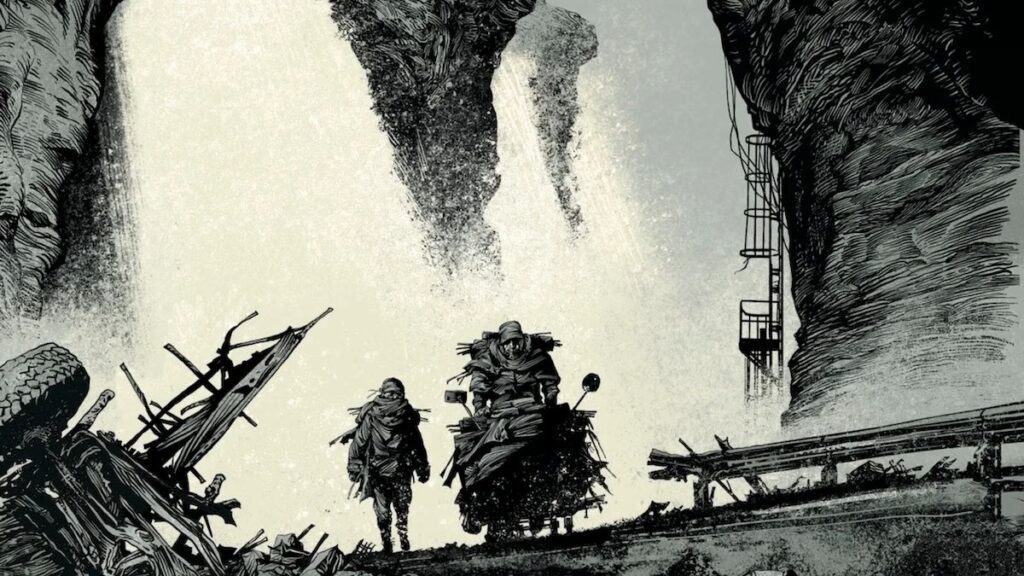The post-apocalyptic landscape depicted in Cormac McCarthy’s “The Road” has haunted readers and viewers since its original release in 2006, captivating audiences with its minimalist prose, bleak world, and harrowing depiction of human survival. The story, centered on the journey of a father and his young son as they navigate a desolate, ash-covered wasteland, speaks to profound themes of hope, despair, and the fragile connections that bind people together in a world ravaged by catastrophe.
With the release of the graphic novel adaptation by French artist Manu Larcenet, the story is brought to life in a new format that offers readers a distinct perspective on McCarthy’s masterpiece. Larcenet, known for his versatility in visual storytelling, sought to remain faithful to McCarthy’s original text while infusing the tale with his own artistic sensibilities. The result is a gripping and visually stunning interpretation of a story that continues to resonate deeply in today’s world. This detailed exploration will delve into how Larcenet’s artistic vision enhances and reframes McCarthy’s “The Road”, exploring the nuances of this unique adaptation.
Larcenet’s Vision for the Graphic Novel
When Manu Larcenet embarked on the project of adapting “The Road” into a graphic novel, he approached it with both reverence and creative passion. McCarthy’s original novel is known for its stark, almost skeletal prose that leaves much to the reader’s imagination. The story is an emotional and psychological journey as much as it is a physical one, and Larcenet’s challenge was to translate this into a visual medium without losing the depth of McCarthy’s words.
Larcenet’s illustrations are a fusion of realism and expressionism, using his art to evoke the psychological weight carried by the characters. He emphasizes the desolation of the landscape through his use of color—largely muted grays and browns, punctuated by occasional moments of light that mirror the fleeting moments of hope the father and son encounter. His detailed depictions of the barren world around them reinforce the sense of loss and isolation that pervades McCarthy’s writing. The ash-covered cities, dead forests, and the remnants of a once-thriving civilization are depicted with a haunting beauty that both captures and elevates the source material.
Faithfulness to McCarthy’s Text
Despite Larcenet’s unique artistic style, the graphic novel adaptation remains faithful to McCarthy’s original novel in terms of tone and narrative structure. Larcenet emphasized his commitment to maintaining the integrity of McCarthy’s words, and the adaptation reflects this. The dialogue is sparse, as in the original, and Larcenet uses silence and the space between panels to convey the loneliness and fear that dominate the characters’ lives.
The graphic novel format, however, offers a different type of storytelling experience. Where McCarthy’s prose leaves much of the world’s physicality to the imagination, Larcenet’s art provides a visual representation that can offer new layers of interpretation. Readers are not only following the father and son’s journey; they are seeing it unfold in ways that were only hinted at in the novel. The brutality of the post-apocalyptic world is laid bare, and Larcenet does not shy away from depicting the horrors that the characters face—whether it is the stark emptiness of the landscape or the terror of encountering other survivors.
At the same time, Larcenet’s art allows for a level of subtlety in the storytelling. He conveys the depth of the father’s love and the son’s fear through their expressions and body language, making the emotional undercurrent of the story even more palpable. In McCarthy’s novel, much is communicated through internal thoughts and sparse dialogue, but in the graphic novel, Larcenet uses his illustrations to expand on these emotional cues, giving readers a more immediate connection to the characters’ experiences.
Impression
One of the most significant advantages of the graphic novel format is its ability to convey atmosphere through visual elements. In “The Road”, the world itself is a character, shaping the journey of the father and son as much as their interactions with each other or with other survivors. Larcenet excels at making this world feel real, alive with dread and decay. His use of light and shadow, in particular, heightens the tension of the narrative, creating a palpable sense of danger lurking around every corner.
The father and son’s journey is one of constant motion through a dead world, and Larcenet captures this through his dynamic use of paneling and composition. The pacing of the graphic novel mirrors the slow, uncertain progress of the characters, with wide, expansive panels often giving way to smaller, more claustrophobic ones when danger arises. The tension between these visual elements keeps the reader on edge, much as McCarthy’s original novel does.
The use of visual symbolism is also key to Larcenet’s adaptation. Throughout “The Road”, the father and son’s journey is punctuated by moments of tenderness, often centered around the small, fleeting comforts they find—a fire, a can of food, the sight of the ocean. Larcenet uses recurring visual motifs, such as the light from their fire or the bleak, empty sky, to reinforce the themes of survival and the fragile hope that sustains them. The fire, which the father often refers to in the novel as something they must “carry,” becomes a powerful visual symbol in the graphic novel, representing both physical survival and the persistence of human spirit.
A New Way to Experience the Story
For readers who are familiar with “The Road”, either through the original novel or the 2009 film adaptation, Larcenet’s graphic novel offers a new way to experience the story. The visual medium allows for a different kind of immersion, one that is both immediate and visceral. While the novel asks readers to imagine the world and the horrors within it, the graphic novel confronts them directly with these images. The result is a reading experience that is both complementary to McCarthy’s text and entirely its own.
For those new to the story, the graphic novel serves as an accessible entry point into McCarthy’s work. Larcenet’s adaptation retains the emotional and thematic core of “The Road” while presenting it in a format that may appeal to readers who might not engage with the original novel’s spare, minimalist prose. The graphic novel also stands as an example of how literary works can be successfully adapted into other forms, offering fresh insights and perspectives while remaining true to the spirit of the original.
Testament to McCarthy’s Legacy and Larcenet’s Craft
Manu Larcenet’s adaptation of “The Road” is a triumph of graphic storytelling. By faithfully translating McCarthy’s haunting prose into visual form, Larcenet has created a work that honors the original while standing on its own as a powerful piece of art. The graphic novel captures the bleakness of the post-apocalyptic world and the fragile hope that sustains the father and son, all while showcasing Larcenet’s unique artistic vision.
For fans of “The Road”, the graphic novel offers a new way to experience a beloved story, adding layers of visual meaning to McCarthy’s words. For newcomers, it serves as an accessible and emotionally resonant introduction to one of the most important works of modern literature. In both cases, Larcenet’s adaptation is a testament to the enduring power of McCarthy’s story and the limitless possibilities of the graphic novel form.
No comments yet.







